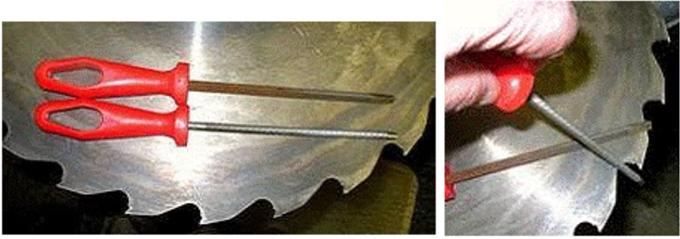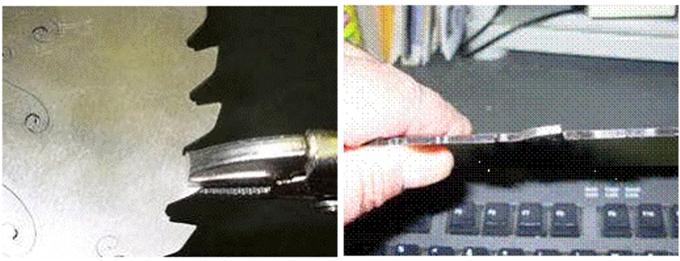Testing Steel Saw Plate
Testing Steel Condition
You can get an excellent idea the condition of the steel after brazing by the color of the steel. There are two other ways of easily and simply telling the condition of the steel.
The left picture above shows the steel saw plate with two ordinary files on it. One of them is a triangular file and the other one is a round file. The right picture above shows the use of a round file. To test the hardness of the steel you simply rub the file over it and see whether it cuts or just slides. If you’re reading this you should be more than skilled enough to tell the difference. If you’ve never used a file on steel then try this and the difference will become readily apparent.
I show a triangular file and a round file. The advantage to the triangular file is that it is much more likely to cut and many feel it gives you a more sensitive test of the hardness. The great disadvantage to the triangular file is that it leaves a notch on the edge of the saw plate. It leaves a sharp, V-shaped notch which is an excellent place for a crack or a tear to start. The round notch does not create a unique stress concentration point as the triangular one does.
If you’re going to run the saw blade after testing you are far and away better off using a round file and the triangular file should be avoided.
There is another way of testing the condition of the steel on the saw shoulder. In this test you grab the steel saw shoulder with a pair of vise grips or similar and you bend it. If the steel bends without breaking it tells you a great deal about how hard and how brittle it is.
The most extreme case of this I have seen was at Cascade Southern Saw Company in Milwaukee, Oregon. As part of the demonstration they took a saw blade with about a two foot diameter and repeatedly bent the shoulder back and forth from side to side. They could flex the steel out about 60° to either side rapidly and repeatedly without snapping or tearing the steel.
The pictures above are of a 10 inch saw blank which is an entirely different situation.
The Cascade Southern test was done on a large saw blade that was meant to be used in a ‘Curve Sawing’ application. In this application the saw blades are placed in a box that moves from side to side to follow the curves of the log being sawn. In order to do this the saws must be more flexible than is common with something like a 10 inch saw blade. However, even with the 10 inch saw blade, you should be able to bend the shoulder out without snapping the steel. I do not recommend that you undertake this test lightly as it takes a real expert to get the shoulder back in alignment properly.
Leave a Reply





